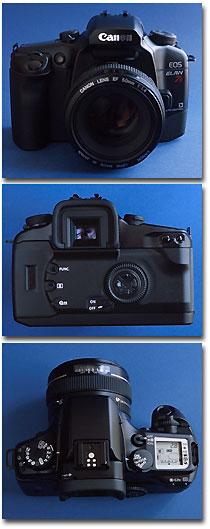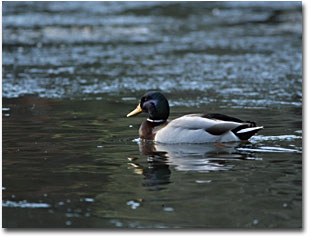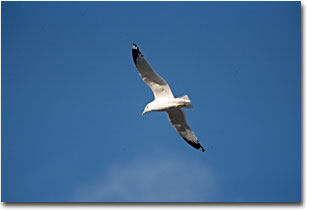My old EOS 630, which I bought used several years ago, had served me well. Used as a backup to my 1n, the 630 was the preferred camera body when I wanted to travel light or needed a second body for when the 1n was secured to the end of a tripod mounted telephoto. Often used with a 28-70/2.8L, the 630 performed this backup/secondary function very well.
Not too long ago, time got the better of the old 630. Having developed an internal short, it would drain a new 2CR5 lithium battery within weeks, without the shutter button ever being pressed. After a little research, I discovered that in all probability, it could be repaired for about $150. However, I remained hesitant to invest that much in an old camera body.
After some thought, I decided to replace it with a new Elan 7E. The Elan is now the fifth EOS camera body I have owned, purchased specifically to fill the niche left void by the now inoperative 630. Small in size and relatively lightweight, the 7E has thus far filled the void very well indeed. Some of the Elan's features which are especially of interest to me include -

- Lightweight at 20.3 oz./575 g.
- Compact in size - 5.5 inches in width, 3.5 inches in height and 2.9 inches in depth.
- Built-in flash with exposure compensation, very handy for short-range outdoor fill flash.
- Independent DOF preview button (silent in operation, like all EOS cameras).
- Independent mirror lock-up that can also be used in conjunction with the camera's 10-second timer.
- Extremely quiet operation.
- A nice selection of 13 custom functions (34 settings), including being able to leave the film leader out on rewind.
- Analog exposure scale in viewfinder.
- A maximum flash synchronization speed of 1/125th of a second, and FP (Focal Plane) flash sync. of up to 1/4000th of a second using a dedicated EX flashgun.
- Stainless steel lens mount.
Some other features of interest include -
- 7-point autofocus.
- Eye-Controlled focus point selection
- Keypad style focus point selector buttons on rear of camera.
- 3 metering patterns including 35-zone Evaluative, center-weighted and 10% partial.
- Pre-flash E-TTL (Evaluative-through the lens) metering with an EX series flashgun.
- Film winding to 4 frames per second (3.5 frames per second in AI servo predictive autofocus mode).
- Uses a pair of CR123A lithium batteries in the grip.
A few useful features that Canon has unfortunately omitted -
- Illumination for the LCD display.
- A 2-second timer, especially useful when used in conjunction with MLU.
- A true spot meter.
Note - Additional technical information on the Canon Elan 7E, along with a complete list of features and specifications can be found here.
Intial Impressions

I was immediately impressed with the overall looks and layout of the Elan 7E. Although the control layout is quite different than the 1n, it took only a few minutes to figure out its operation. A few references to the owners manual was all that was required to set the custom functions to my liking. While the metal top and bottom covers probably don't add anything of significance strength-wise, the Elan 7E does feel more solid in the hand than its predecessors or the A2. I also find its all-black finish very attractive.
Eye control (EC) was something I had mixed feelings about and was tempted to buy the Elan 7, which omits the feature. However, the difference in price is only about $50, and both the 7 and 7E incorporate a viewfinder dioptric adjustment. After reviewing the simple calibration procedure in the owner's manual, it took less than 30 seconds to perform a single calibration. With just this single calibration, the eye control worked perfectly with both horizontal and vertical camera holds. The real test came that evening, when I took out my contact lenses and donned the spectacles. Even wearing eyeglasses, EC still reliably tracked my eye movement with just the single calibration! OK, so I was impressed, but at that point it still remained questionable in my mind about how useful EC would be under real life shooting conditions.
In the Field
The first test came during our visit to the PMA Trade Show in Orlando, where I used the Elan 7E with an EF 50/1.4 USM lens. Loaded with Kodak Portra 800, I took a few meter readings in the convention hall, set the camera to 1/90th of a second at f/2.8 in manual exposure mode, and set flash exposure compensation to a minus 1.5 EV. The eye control continued to work well and all negatives looked sharp with plenty of density. Some of these images can be found in this month's review of the PMA Show.
The following week, I had the opportunity to spend some time at a local park that's home to a wide variety of waterfowl. Loaded with Kodak Elitechrome 200, the Elan 7E was used with a tripod mounted EF 300/4L and at times, with a Canon 1.4X teleconverter. Autofocus operation proved to be very swift and sure. I did notice that when the sun was behind and off to the side of me, creating a glare in the viewfinder, EC really struggled. If I turned so that no direct sunlight spilled onto the viewfinder, EC worked fine. Perhaps Canon should offer an oversize eyecup, as they do with the A2E. Nonetheless, eye control proved to be a very useful feature in the field, one that I will no doubt use on a regular basis. In those unusual situations where EC does not perform as well, it is easily turned off.

It was the ability of the Elan 7E to track flying birds hand held with the EF 300/4L that was especially impressive, having little difficulty with fast moving, low flying gulls. I found that the Elan tracked these hard-to-follow gulls more reliably with EC turned off and all 7 autofocus sensors activated. The Elan 7E advances film at a rate of 3.5 frames per second in AI predictive autofocus mode, keeping the flying birds sharp in just about every frame. In all honesty, I felt as though it outperformed my 1n in that department.
Conclusion
The Elan 7E may be the best value in an EOS camera I have ever owned. After using the A2, 650, 630 and 1n, I can see that the newest Elan could very quickly become my favorite camera body. While the 1n impresses with its superb built and performance, total reliability and wide range of very practical features, the new Elan has refilled a niche for me that is equally important. Compact, lightweight, attractively designed and finished, and extremely capable, the new Canon EOS Elan 7E is the perfect travel/backup camera, and may be the only camera a serious nature photographer on a budget will ever need.
About the Images
Mallard Drake - Highly reflective surfaces, including water and ice, will often fool a meter into underexposure. The Elan 7E's 35-zone evaluative meter handled this scene perfectly. Elan 7E, EF 300/4L with matching 1.4X teleconverter, Bogen 3221 tripod, EC focus point selection in Al Servo (continuous autofocus) mode, f/5.6 (shutter speed unrecorded) in AV mode, Kodak Elitechrome 200. Image represents approximately 70% of the original frame.
Gull - The Elan 7E's 7-point autofocus system tracked these flying gulls with amazing precision, perhaps even better than the EOS 1n. Elan 7E set in Al Servo (continuous autofocus) mode, automatic focus point selection, EF 300/4L handheld, f/4 in AV mode (shutter speed unrecorded), 35-zone evaluative metering with plus 1 EV compensation, Kodak Elitechrome 200, full frame image.
JE-NPN

